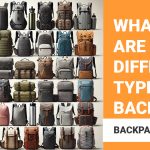The overwhelming amount of options for backpacks left me feeling insecure and worried. How could I possibly choose the right backpack for backpacking among the sea of brands and designs? Each person has their own individual needs and preferences, making it difficult to suggest a specific brand or style.
In this guide, I’ll discuss the different types of backpacks, key features to look for, and how to identify the best fit based on your needs. Our goal is to provide you with the necessary information to make an informed decision and find a backpack that suits your body, meets your needs, and simplifies your daily routine.
How To Understand Which Backpack You Need?
Assess Your Primary Purpose
Picking the right backpack starts with understanding its purpose. For daily commuting, you need a durable, comfortable pack with compartments for essentials like a laptop and lunch. Students should opt for a roomy, manageable bag with strong straps for books and a laptop.
Travel backpacks should offer multiple compartments and security features, while hiking packs need to be rugged with hydration systems and weather resistance.
Determine Capacity
Capacity is also crucial. Backpacks are measured in liters, with daypacks typically around 10 liters and larger packs reaching up to 70 liters. Consider what you regularly carry to ensure you select the right size.
How Do You Know If A Backpack Is Good Quality?
Quality in a backpack goes beyond brand or appearance—it’s about performance and durability. Material choice is crucial; high-denier nylon offers durability, while Dyneema is strong and lightweight. Ensure stitching is reinforced at stress points to prevent wear. Reliable zippers like YKK and sturdy buckles are essential for security. Comfort matters, so look for padded, adjustable straps and a well-placed hip belt. Internal frames and breathable back panels aid in load support and comfort. Consider durability vs. weight based on your needs, and if you’re outdoors often, prioritize weather-resistant features.
What Are The 3 Main Types of Backpacks?
The 3 main types of backpacks are traditional, ultralight, and hybrid.
Traditional Backpacks
These are robust and padded, with internal or external frames for heavy loads. Internal-frame packs hug the body and are great for stability, while external-frame packs excel in ventilation and bulky gear transport.
Ultra-Light Backpacks
Designed for minimalists, these packs focus on reducing weight. Frameless versions are extremely light but offer less support, making them suitable for seasoned backpackers with light loads.
Hybrid Backpacks
Combining features of traditional and ultra-light packs, hybrids offer a balanced approach. They have a minimalist frame or removable components, making them versatile for various needs.
Why Proper Backpack Fit Is Important?
A well-fitted backpack feels like an extension of your body, providing stability, balance, and support. Proper fit is crucial for a comfortable and strain-free experience. By evenly distributing weight, with most of the load resting on your hips rather than your shoulders, it reduces stress on your back and shoulders. This makes the load feel lighter and minimizes the risk of injuries like back pain and shoulder strain. When your pack fits correctly, it won’t dig into your shoulders or strain your back, enhancing your overall comfort and enjoyment during your journey.
How to Size and Fit a Backpack?
Torso Length
To find the right backpack fit, start by measuring your torso length. Measure from the C7 vertebra at the base of your neck to the top of your hip bones. This will help you choose a pack that matches your torso length.
West Size
A well-fitted hip belt is crucial, as it should carry most of the weight. Measure around your hips to find your waist size and ensure the belt adjusts snugly, distributing the load effectively.
Women-specific
Women-specific backpacks offer a better fit for smaller frames, with adjusted torso dimensions and hip belts. These backpacks are slightly smaller but have adjustable straps, ensuring comfort and support.
youth-specific
youth specific is for younger users,these backpacks have smaller capacities and adjustable straps, ensuring comfort and support.
Adjusting Straps and Features for Optimal Fit and Weight Distribution
To achieve the perfect backpack fit, adjust key straps: shoulder straps should be snug, the hip belt must rest comfortably on your hips to transfer weight, and the sternum strap or chest strap should stabilize the load without restricting breathing. Waist belts can carry 80% of the weight of the bag. It also keeps the bag tight and the valuables safe inside. Some waist belts also have straps or loops in them to carry different tools. Load lifters bring the pack closer to your body for better balance. Key features like hip belts,hip belt stabiliser, load lifters, compression straps, shoulder harness, padded yoke system, gear loops and internal frames enhance weight distribution by shifting the load to your hips, balancing it between hips and shoulders, and keeping it compact and stable. Proper adjustments and features help reduce discomfort and make the pack easier to carry.
Belts, load lifters, compression straps, and internal frames enhance weight distribution and balance, making your pack easier to carry and less strain on your body.

How Many Litres Do I Need For A Backpack?
Generally, the size of a backpack starts from 10 liters and goes up to 70 liters or more. Imagine you’re Goldilocks trying to find the perfect backpack. If it’s too small, you’ll struggle to fit everything inside. If it’s too big, you’ll be weighed down like carrying a heavy chain. So, let’s choose the size that fits just right before it’s too late!
What is a good size for an everyday backpack?
Small Backpacks (10-20L)
For minimalists, a small backpack between 10-20 liters is ideal. It’s perfect for carrying essentials like a water bottle, book, lunch, and small items. These bags are great for short trips or commuting without being weighed down. But if you like to be prepared for everything, you may need more space.
Medium Backpacks (21-30L)
For a versatile option, choose a medium backpack in the 21-30 liter range. These bags are like Swiss Army knives, perfect for school, work, and short trips. They can hold a laptop, change of clothes, and other essentials without feeling overloaded – a solid choice for handling various situations.
Large Backpacks (31-40L)
A backpack between 31-40 liters is perfect for those who like to be prepared for anything. It’s great for gym-goers, travelers looking to avoid checking a bag, or anyone who wants extra space. But remember, don’t overstuff it unless you’re ready to carry the weight.
What Is The Best Size Backpack For Travelling And Specific Uses?
Travel Backpacks (40-70L)
For weekend trips, a 40L travel backpack is ideal for carry-on purposes. But for longer adventures, consider a 60L or 70L pack to ensure enough space. Keep in mind, the bigger the bag, the more you may be tempted to overpack and your back will thank you for packing lighter.
Hiking and Adventure Backpacks
Heading into the great outdoors? Your backpack size depends on the length of your hike and the gear needed. For a weekend hike for 1-3 days, a smaller pack (30-50L) is sufficient for water, snacks, and a light jacket. For multi-day treks of 3-5 days, you’ll need a larger pack (50-70L) to carry a tent, sleeping bag, and food. Trips of 5 days or more will require a 70L+ pack with room for a 4-season tent and extra clothes. Avoid ending up with a too-small or too-large pack by choosing the right size for your adventure.
Specialized Backpacks
If you need to carry cameras or gadgets, you’ll want a backpack made for that. They come in different sizes with special pockets to keep your stuff safe and organized. Size doesn’t just mean how much it can hold, it also means keeping your things safe and easy to get to.
Is It Better To Size Up or Down A Backpack?
Here’s the million-dollar question: Should you size up or down? Bigger means flexibility but also a heavier bag. Smaller forces smart packing, but maybe not enough space. The sweet spot is a bag that fits daily essentials with some extra room, without being too much.
Choosing the right backpack means understanding its features and functionality. These elements make a pack a reliable companion for all your adventures. Let’s explore the essential features that can make or break your experience.
What Are The Different Types of Frames in Backpacks?
Frame Type
Internal-Frame Backpacks
The majority of traditional packs you’ll see today are internal-frame models. The structure is hidden inside the back panel, which means they hug your body closely. This design keeps you stable on uneven, off-kilter terrain, transferring the load to your hips where you can carry it more comfortably. They also feature various load-support technologies, all geared toward making your hike more manageable.
External-Frame Backpacks
External-frame packs are a bit old-school, but they’re still the right choice for some situations. Here, the structure is visible—usually made of aluminum—sitting on the outside of the pack. Because the frame extends beyond the pack itself, these are great for carrying heavy, irregular loads like an oversized tent or an inflatable kayak. Plus, they offer excellent ventilation and plenty of gear organization options, making them ideal for hot weather or bulky loads.
Frameless Backpacks
Taking the ultra-light concept to the extreme, frameless backpacks forgo a rigid frame altogether. This makes them incredibly lightweight, but they’re only comfortable with very light loads. They’re perfect if you’re a seasoned backpacker who knows how to pack efficiently and doesn’t need the support of a frame. However, be aware that without a frame, carrying heavy loads can quickly become uncomfortable.
What Are The Main Features and Functionality of A Backpack?
Multiple Compartments For Gear Organization
Backpacks come with a variety of compartments for a reason to keep your gear organized and easily accessible, avoiding a messy search. For example, a separate compartment for snacks means not digging through clothes to find an energy bar.
Specialized Pockets
Specialized pockets are a dream for organization lovers. Most backpacks have padded laptop sleeves for tech protection and water bottle holders for easy access to hydration. Some even have insulated compartments to keep drinks cool, perfect for hot weather.
Hydration Systems
Staying hydrated is essential for outdoor activities, and hydration-compatible backpacks make it easy. Many packs include an internal sleeve for a hydration bladder, offering hands-free drinking via a hose. Alternatively, dedicated pockets for water bottles are available, providing convenience and versatility during your adventures.
Ventilation Systems and Breathability
Ventilation is a key feature in backpacks, especially for preventing sweaty backs during long treks. Some packs use a suspended mesh back panel, creating a breathable gap between your back and the pack, which reduces sweat buildup. Others feature ventilation channels or you can say the chimney of the backpack in the back panel to promote airflow, keeping you cooler and more comfortable.
Pack Access
How easily and efficiently you can access your gear is crucial when choosing a pack. Traditional top-loading packs allow for access from above, but newer designs with side zippers and front-panel openings make it easier to reach items buried deeper in the pack, saving time and frustration. The number and size of pockets also vary, with stretchy side pockets perfect for holding water bottles within easy reach while wearing the pack. Hip belt pockets are great for keeping small essentials like snacks or a phone close at hand. Many modern 3-season packs now feature shovel pockets, originally intended for snow shovels but now used as convenient stash spots for maps, jackets, or other lightweight items. And don’t forget about the top lid pocket, or “brain,” which comes in different single or multi-compartment designs to cater to different organizational preferences.
Removable Daypack
A removable daypack is a versatile option for those who need a smaller pack for day trips. They can easily detach from the main pack, allowing you to travel light. They’re great for quick trips or situations where a large pack would be too much.
Sleeping Bag Compartment
A dedicated sleeping bag compartment is a must-have for backpackers. It keeps your sleeping bag clean and dry, easily accessible at the bottom of your pack after a long
Padding
Comfort is crucial for long hikes or heavy loads. Padded straps, belts, and back panels evenly distribute weight and reduce pressure points, but the amount of padding affects the weight of the pack. High-end packs use lightweight yet supportive foams. Make sure your pack fits properly before heading out.
Attachment Points
Attachment points are like the Swiss Army knife of backpack features—they let you customize how you carry extra gear.
Daisy Chain
A daisy chain is a row of webbing loops sewn onto a backpack for attaching extra gear such as carabiners, pouches, or even bulky items like a sleeping pad. This feature is useful for mountaineers and climbers who need to carry gear externally.
Reinforced Crampon Patch
For winter sports and mountaineering enthusiasts, a reinforced crampon patch is essential. This durable section of the pack can withstand sharp points of crampons and other climbing gear, allowing for worry-free attachment.
Gear Loops, Tie-Downs, and Other Specialized Features
Gear loops and tie-downs allow for easy attachment of external gear, from trekking poles to skis. Some packs even have specialized loops for ice tools and helmets, perfect for technical activities.
Raincover
Lastly, Don’t forget the rain cover! Even if your pack is waterproof, it adds an extra layer of protection. Most packs have a built-in cover stored in a pocket for easy use during bad weather, keeping your gear dry and safe.

What Are The Most Popular Backpack Colors?
Backpacks in neutral shades, such as black, grey, and navy, are enduringly popular due to their versatility but for daily use Beige, Cognac, bold colors and prints are also trendy right now which does have the ability to complement any outfit, and ability to conceal dirt and signs of use. When choosing a backpack, it’s important to find one that meets your practical requirements while also reflecting your personal taste. Whether you lean towards a rugged, outdoor look or prefer a more sophisticated design, your backpack should align with your style.
How Much Should A Backpacking Pack Cost?
When choosing a backpack, your budget directly impacts the quality and features you can expect. Backpacks range in price from $20 to over $300, with each tier offering different benefits. Basic packs under $50 are designed for light use and often lack durability. In the $50 to $150 range, you’ll find more durable materials and added features like water resistance, making them ideal for everyday use. Mid-range packs ($150 to $300) offer advanced features and higher durability, suited for travelers and outdoor enthusiasts. Premium backpacks over $300 are top-tier, with superior materials and craftsmanship, making them long-lasting investments for serious users.
Value vs. Cost
When considering backpack costs, look beyond the initial price and think about long-term value. A quality pack with ergonomic straps, good weight distribution, and durable materials will provide comfort and security for valuable items. So while budget is important, it’s worth investing in a quality backpack for durability, functionality, and overall experience.
How Long Should A Backpack Last?
A well-cared-for backpack can last years, even last over 10 years. However, if you notice fraying fabric, broken zippers, or lost padding, it’s time to consider a replacement. Replace your backpack when it compromises comfort, safety, or gear protection. If it’s still functional but worn, keep it as a backup.
How To Maintain A Backpack?
Proper cleaning and maintenance are crucial for your backpack’s longevity. Hand wash gently with mild detergent, or spot clean when needed. Air dry to protect the fabric. If machine-washable, use gentle cycle and avoid frequent washing to extend its lifespan.
Knowing when to replace your backpack is important; significant wear and tear can affect comfort and functionality. Regular upkeep can delay the need for a replacement and keep your gear protected during your adventures.
FAQ on Choosing The Best Backpack-
-
Are backpacks better than shoulder bags for your back?
Yes, backpacks are generally better for your back than shoulder bags. They distribute weight evenly across both shoulders, reducing strain on your spine, while shoulder bags place uneven pressure, which can lead to discomfort and long-term issues.
-
What should I pack in my hunting backpack?
A hunting backpack is mainly used for carrying all the necessary items or tools that can be helpful for hunting. Many professional hunters always choose a specific set of gear for hunting.
Some hunters also change the items in their bags according to the requirements or time of the hunting. Mostly the common things you should pack will be weapons, ammo, rifles, bows, scents, first aid kit, binoculars, hunting outfits, gloves, hunting knives, and so on.
-
How to wash a hiking or hunting backpack?
It is not a hard thing to wash a hiking or hunting pack. Just like normal backpacks, you can wash them in soap water for 30 minutes. But if there is blood on it then you should clean the blood first with a power washer or a scrub. Then use a detergent to kill the germs and clean the backpack perfectly with a nice hanging dry.
-
What kind of backpack is good for your back?
A backpack that supports spinal health should have padded, adjustable straps and a padded back panel. Research indicates that models with a waist belt can reduce the load on the shoulders by up to 30%, improving comfort and posture. Aim for a backpack that weighs no more than 10-15% of your body weight.
-
Is 40 too old to backpack?
No, 40 is not too old to backpack. Many people in their 40s and beyond enjoy backpacking. Studies show that staying active through activities like backpacking can improve cardiovascular health and mental well-being at any age. Proper preparation and fitness are key to enjoying the experience.
-
What is the correct height to wear a backpack?
The correct height to wear a backpack is at your waist or slightly above, with the top of the pack resting close to your shoulders. This positioning helps distribute weight evenly, reducing strain on your back. Adjust the shoulder straps so the backpack sits snugly against your body without sagging.
-
What is the difference between a backpack and a rucksack?
A backpack is typically a smaller bag with two shoulder straps designed for everyday use, while a rucksack is a larger, more robust bag often used for outdoor activities. Rucksacks generally feature a top flap and are made from durable materials, making them suitable for hiking and camping, whereas backpacks are often designed for more casual settings.
-
What size backpack fits under most airline seats?
A backpack that fits under most airline seats typically measures around 18 to 20 inches in height, 14 inches in width, and 8 to 10 inches in depth. However, it’s essential to check the specific airline’s guidelines, as dimensions can vary. A well-structured backpack within these measurements can ensure easy storage and accessibility during your flight.
-
What is PALS on a backpack?
PALS stands for “Pouch Attachment Ladder System.” It is a grid of webbing sewn onto backpacks, primarily military or tactical ones, allowing users to attach additional pouches and gear securely. This system enhances customization and organization, making it easier to carry essential items based on individual needs.
-
What is an Alice pack?
An Alice pack, short for All-Purpose Lightweight Individual Carrying Equipment, is a military backpack designed for soldiers to carry gear. It features a sturdy, frame-supported design and multiple compartments for organization. The pack is known for its durability and versatility, making it suitable for various outdoor activities. It typically comes in two sizes: medium and large, allowing for different load capacities.
-
What’s a MOLLE system?
The MOLLE system, which stands for Modular Lightweight Load-carrying Equipment, is a webbing framework used on tactical gear, including backpacks. It allows users to attach and customize various pouches and accessories through a series of horizontal straps. This modular design enhances versatility and organization, enabling users to configure their gear based on specific needs and missions.
-
What is the difference between Molle and Alice?
ALICE packs are designed for durability and simplicity with a fixed design, while MOLLE systems offer modularity and customization, allowing users to attach various pouches. ALICE is more traditional, whereas MOLLE adapts to modern tactical needs.
Conclusion
Choosing the right backpack is a personal decision, tailored to your unique needs and lifestyle. There’s no one-size-fits-all solution. Whether you prefer a traditional, ultralight, or hybrid pack, the key is finding one that meets your specific requirements.
Consider the features, comfort, and budget, keeping in mind that the best backpack should feel like a natural extension of yourself—enhancing your journey, wherever it may lead.




